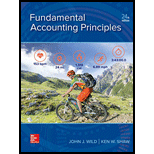
Concept Introduction:
Days Payable outstanding (DPO):
Days payable outstanding is the time in days which the company takes to pay off its accounts payable. Day's payable outstanding is calculated using the following formula:
Requirement-1:
To Calculate:
Days Payable outstanding for Current Year
Answer to Problem 13E
Days Payable outstanding for Current Year is 25
Explanation of Solution
Days Payable outstanding for Current Year is calculated as follows:
| $ Millions | Current Year |
| Accounts Payable (A) | $ 1,931 |
| Cost of Goods Sold (B) | $ 28,164 |
| Days Payable Outstanding = (A*365/B) | 25 |
Concept Introduction:
Days Payable outstanding (DPO):
Days payable outstanding is the time in days which the company takes to pay off its accounts payable. Day's payable outstanding is calculated using the following formula:
Requirement-2:
To Calculate:
Reduction in Days Payable outstanding if accounts payables are reduced by 8%
Answer to Problem 13E
Reduction in Days Payable outstanding if accounts payables are reduced by 8% shall be 2 days
Explanation of Solution
Reduction in Days Payable outstanding if accounts payables are reduced by 8% is calculated as follows:
| Before Reduction in Accounts Payable: | |
| $ Millions | Current Year |
| Accounts Payable (A) | $ 1,931 |
| Cost of Goods Sold (B) | $ 28,164 |
| Days Payable Outstanding = (A*365/B) | 25 |
| After Reduction in Accounts Payable: | |
| $ Millions | Current Year |
| Accounts Payable (A) (1931*92%) | $ 1,777 |
| Cost of Goods Sold (B) | $ 28,164 |
| Days Payable Outstanding = (A*365/B) | 23 |
| Reduction in Days Payable Outstanding (25-23) | 2 |
Concept Introduction:
Days Payable outstanding (DPO):
Days payable outstanding is the time in days which the company takes to pay off its accounts payable. Day's payable outstanding is calculated using the following formula:
Requirement-3:
To Calculate:
Increase in Days Payable outstanding if accounts payables are increased by 8%
Answer to Problem 13E
Increase in Days Payable outstanding if accounts payables are increased by 8% shall be 2 days
Explanation of Solution
Increase in Days Payable outstanding if accounts payables are increased by 8% is calculated as follows:
| Before Increase in Accounts Payable: | |
| $ Millions | Current Year |
| Accounts Payable (A) | $ 1,931 |
| Cost of Goods Sold (B) | $ 28,164 |
| Days Payable Outstanding = (A*365/B) | 25 |
| After Increase in Accounts Payable: | |
| $ Millions | Current Year |
| Accounts Payable (A) (1931*108%) | $ 2,085 |
| Cost of Goods Sold (B) | $ 28,164 |
| Days Payable Outstanding = (A*365/B) | 27 |
| Reduction in Days Payable Outstanding (27-25) | 2 |
Want to see more full solutions like this?
Chapter D Solutions
Fundamental Accounting Principles
- I am looking for a step-by-step explanation of this financial accounting problem with correct standards.arrow_forwardCould you help me solve this financial accounting question using appropriate calculation techniques?arrow_forwardI need help solving this financial accounting question with the proper methodology.arrow_forward
- Kindly help me with this General accounting questions not use chart gpt please fast given solutionarrow_forwardPlease explain the solution to this financial accounting problem with accurate principles.arrow_forwardHello tutor please given General accounting question answer do fast and properly explain all answerarrow_forward
- I need help solving this general accounting question with the proper methodology.arrow_forwardBased on the results of the Accounts Receivable Aging as of December 31, 2022 visualization, what conclusion can be made regarding the outstanding accounts receivables? a. The count of unpaid invoices was the highest for invoices within the 90+ days aging group and the lowest for invoices in the 31-60 days aging group. b. The count of unpaid invoices was the highest for invoices within the 31-60 days aging group and the lowest for invoices in the 90+ days aging group. c. The outstanding accounts receivable value for the 90+ days aging group is approximately the value of the other aging groups combined. d. The outstanding accounts receivable value for the 90+ days aging group is approximately twice the value of the other aging groups combined.arrow_forwardPlease given correct answer for General accounting question I need step by step explanationarrow_forward

 AccountingAccountingISBN:9781337272094Author:WARREN, Carl S., Reeve, James M., Duchac, Jonathan E.Publisher:Cengage Learning,
AccountingAccountingISBN:9781337272094Author:WARREN, Carl S., Reeve, James M., Duchac, Jonathan E.Publisher:Cengage Learning, Accounting Information SystemsAccountingISBN:9781337619202Author:Hall, James A.Publisher:Cengage Learning,
Accounting Information SystemsAccountingISBN:9781337619202Author:Hall, James A.Publisher:Cengage Learning, Horngren's Cost Accounting: A Managerial Emphasis...AccountingISBN:9780134475585Author:Srikant M. Datar, Madhav V. RajanPublisher:PEARSON
Horngren's Cost Accounting: A Managerial Emphasis...AccountingISBN:9780134475585Author:Srikant M. Datar, Madhav V. RajanPublisher:PEARSON Intermediate AccountingAccountingISBN:9781259722660Author:J. David Spiceland, Mark W. Nelson, Wayne M ThomasPublisher:McGraw-Hill Education
Intermediate AccountingAccountingISBN:9781259722660Author:J. David Spiceland, Mark W. Nelson, Wayne M ThomasPublisher:McGraw-Hill Education Financial and Managerial AccountingAccountingISBN:9781259726705Author:John J Wild, Ken W. Shaw, Barbara Chiappetta Fundamental Accounting PrinciplesPublisher:McGraw-Hill Education
Financial and Managerial AccountingAccountingISBN:9781259726705Author:John J Wild, Ken W. Shaw, Barbara Chiappetta Fundamental Accounting PrinciplesPublisher:McGraw-Hill Education





